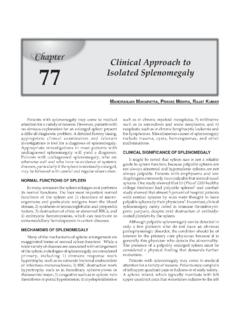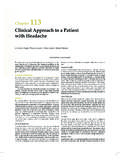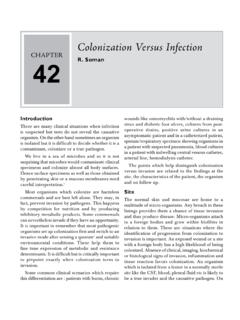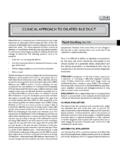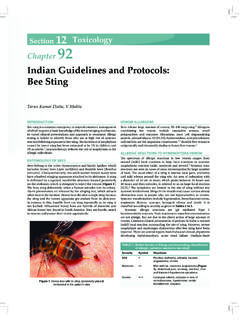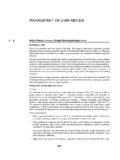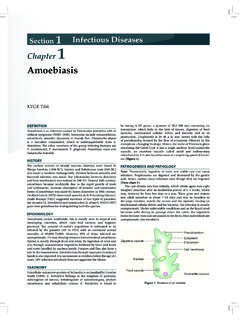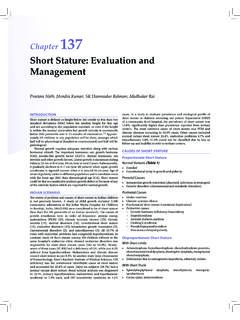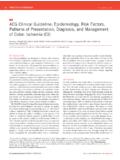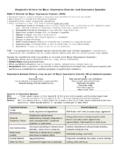Transcription of Isolated systolIc hypertensIon - API
1 111 Isolated systolIc hypertensIonRaminder Singh, MumbaiUntil the 1980 s the diastolic blood pressure (DBP) was assumed to be the most relevant hemodynamic parameter for prognosis of hypertensive patients. Elevated systolIc pressure was considered as an inevitable consequence of aging and many physicians were reluctant to pay credence to the need for therapy of elevated systolIc blood pressure. There was a radical change in thinking based on epidemiological studies and reports by insurance companies which led to recognition of elevated systolIc blood pressure (SBP). The term Isolated systolIc hypertensIon (ISH) has been introduced particularly in elderly subjects, since SBP is known to rise with advancing age; where as diastolic blood pressure (DBP) usually levels off and tends to decrease in According to the National Health and Nutrition Examination Survey (NHANES) III, ISH is the most prevalent type of untreated hypertensIon over 60 years of age.
2 ISH represents a substantial health care problem as the target BP is very difficult to attain by drug to JNC-VI and WHO/ISH guidelines, ISH is now defined as BP >140/<90 mmHg, this criteria is more stringent than older definition of ISH >160/< Etiology of iSHApart from ISH seen with advancing age, ISH can also be seen in young patients 3 (obese, smokers, low education and socioeconomic status), hyperthyroidism, hyperaldosteronism, renal insufficiency and failure, renal artery stenosis, drug induced (NSAIDS, COX-2 inhibitors, corticosteroids, cyclosporine), herbal remedies, excess alcohol use, obstructive sleep apnoea, anaemia, beriberi, Paget s disease and cancer (due to release of humoral pressor substances or hypercalcemia). PatHoPHySiology of iSHISH largely reflects progressive structural and functional deterioration of arterial wall involving endothelial dysfunction, atherosclerosis, aortic stiffness and increased wall stress and pulse pressure. According to the hypothesis, atherosclerosis, triggered by vascular endothelial damage and mechanical strain from each stroke volume, plays a central pathophysiological role.
3 Atherosclerosis progressively leads to the replacement of elastin by collagen and other structural proteins and the build of calcium in the arterial wall, and this in turn leads to hypertrophy and fibrosis of arterial smooth muscle. All these factors lead to increased vascular stiffness which results in reduction in arterial compliance and decreased of Windkessel function of large angiotensin system plays an important role in pathogenesis of arterial stiffness by decreasing elastin content and increasing collagen of arterial wall. Proliferating small muscle cells in the arterial wall results in increased thickness, stiffening, and partial loss of contractility. 4 ClaSSifiCation of iSHISH is classified as shown in Table and SignSIn most elderly, ISH is asymptomatic. Epistaxis may be a presenting feature. Cardiac dysfunction is indicated by symptoms of coronary artery disease, heart failure, arrhythmias. Stroke, intermittent 3 : 2 Medicine Update 2012 Vol. 22112claudication due to peripheral arterial disease, aortic aneurysm, aortic dissection, features of hypertensive retinopathy, renal insufficiency or failure may be present.
4 Severe hypertensIon or an abrupt rise of BP may cause headache, blurred vision or of iSHAn initial evaluation of ISH should include assessment for other cardiovascular risk factors, end organ damage, identifiable secondary causes of hypertensIon and potentially contributing lifestyle factors (diet, exercise, alcohol, smoking, body weight, drugs). Physical examination should include assessment of peripheral pulses, optic fundi, thyroid, heart, lungs, kidney and neurological system. Abdominal and carotid bruit should be carefully BP Monitoring (ABPM) is of value in elderly patients to confirm the diagnosis of hypertensIon if clinic BP is more than 140/90 mm Hg (White coat effect), to identify non dippers and to assess response to drugs. Home BP measurement (HBPM) can be suitable alternative to monitor the response to treatment. The devices are easily available and user friendly. Investigations for end organ damage should include hematocrit, urine analysis for proteinuria, BUN, serum creatinine, uric acid, electrolytes (sodium, potassium, calcium), blood glucose, lipid profile, thyroid function test, ECG, X-ray chest.
5 Echocardiography, carotid doppler, renal doppler, CT abdomen/ chest, USG abdomen and polysomnography (in obese subjects) may also be aS a riSk faCtorThe Framingham study5 and The Multiple Risk Factor Intervention Trial6 (MRFIT) showed that SBP levels are stronger predictors of cerebrovascular and cardiovascular events than diastolic BP (DBP). It should be realized that a too low DBP is also dangerous in those with coronary artery disease. DBP below 60 mm Hg may be associated with an increased risk of myocardial infarction and death (J curve phenomenon).7 Several intervention studies in ISH have demonstrated beneficial effects of treatment of ISH. BEnEfitS of trEatmEnt of iSH Several interventional trials such as STOP-1, STOP-2 and MRC Elderly have clearly demonstrated that treatment of hypertensIon in elderly is beneficial and protective against stroke8 and coronary artery disease. In most of these trials, no clear distinction was made between ISH and ordinary hypertensIon .
6 However a major percentage of elderly hypertensives recruited for such studies showed hemodynamic characteristics of ISH. A few clinical trials have enrolled patients with well defined ISH. intErvEntionS trialS ConCErning iSH systolIc hypertensIon in the Elderly (SHEP)9 Elderly patients with defined ISH were treated with low dose chlorthalidone (with the option to add atenolol or reserpine), in comparison with placebo. Active treatment brought about the following significant beneficial changes / reductions: non- fatal stroke 37% nonfatal MI 33% left ventricular failure 54%There were obvious trends (although not significant) towards decrease in TIAs (-25%) Total mortality (-13%) Cardiovascular mortality (-20%) Cerebrovascular mortality (-29%) Coronary mortality (-15%)In addition, this study has confirmed and emphasised the beneficial effects and safety of low dose diuretics in elderly hypertensIon in Europe (SYST-EUR)10 TrialIn large number of ISH patients active treatment with the calcium antagonist nitrendipine (with optional add on enalapril and /or hydrochlorothiazide) was compared with placebo, in a double blind randomized significant reduction (by 42%) in the incidence of stroke and vascular dementia (by -50%) by nitrendipine treatment was hypertensIon in China (SYST-China)11 TrialThe design of this trial, performed with Chinese ISH patients, was very similar to that of the SYST-EUR study.
7 In the Chinese table 1 : Classification of iSHCategoryBlood Pressure (mmHg)SystolicDiastolicOptimal<120 And<80 Normal<130 And< 85 High-normal130-139Or80-89iSHStage 1140-159 And<90 Stage 2160-179 And<90 Stage 3 180 And<90113isolated systolIc Hypertensionpatients active treatment with nitrendipine significantly reduced the following endpoint phenomenon: total stroke 38% stroke mortality -58% all cause mortality -39% cardiovascular mortality -39% fatal and non-fatal cerebrovascular events -37%Intervention as a Goal in hypertensIon Treatment (INSIGHT)12 Study The INSIGHT study was performed in hypertensive patients with at least one additional risk factors such as hyperlipidemia or diabetes mellitus. The study was not deliberately designed to investigate ISH treatment, but it contained a subgroup of patients with defined ISH which were analysed consisted of nifedipine (in the GITS form: Adalat-OROS), versus hydrochlorothiazide. This subgroup of patients appeared to be more responsive than those with ordinary hypertensIon to treatment with nifedipine GITS.
8 Interestingly, in these study patients with ISH whose DBP significantly decreased with increasing therapy were smokers with evidence of types of treatment (calcium antagonist vs diuretic) caused a significant and sustained reduction in blood pressure (in particular SBP) and a significant reduction of the relevant endpoint parameters, such as stroke and Intervention For Endpoint reduction (LIFE) 13 studyThe ISH substudy of LIFE compared Losartan with atenolol and demonstrated that losartan reduced the risk of stroke and CV death to greater degree than II receptor antagonist telmisartan in Isolated systolIc hypertensIon (ARAMIS)14 studies: Telmisartan (20 80 mg) produce significant reduction in SBPV alsartan in Isolated systolIc hypertensIon (VALISH)15 This study showed a significant effect on studies on ISH ACE inhibitors like lisinopril, Enalpril, Periondopril are also suitable for blood pressure control in ISH patients and favourably influence cardiovascular risk factors.
9 In conclusion, it appears mandatory and possible to treat ISH and there is sufficient evidence that has demonstrated beneficial effects of this of Isolated systolIc HyPEr-tEnSionThe management of ISH should start with lifestyle changes followed by drug life style changes: The lifestyle changes recommended for patients with Isolated systolIc hypertensIon are the same as those for patients with other forms of hypertensIon . a. Weight reduction: Decrease in body weight de-creases the incidence of hypertensIon and the vice-versa is also true, reduction in body weight decreases blood pressure by mmHg. It improves insulin sensitivity, sleep apnoea and the sensitivity to sodium decreases. It is advisable to maintain ideal body weight (BMI kg/m2). b. Dietary sodium restriction: Moderate degrees of so-dium restriction to gm/day results in SBP reduc-tion by 2 - 8 mm Hg. Indian patients with ISH are more responsive to sodium restriction, because of their lower renin responsiveness.
10 In Indians there is hidden salt in many food items and common practise to consume items (pickle, papad, sausages) which are loaded with sodium. c. Diet Changes: Role of diet has been proven in DASH (Dietary Approaches to Stop hypertensIon ), TONE16 (Trial of Nonpharmacological Interven-tions in the Elderly), and many more trials. The diet should be rich in fruits, vegetables, low in saturated and total fat and high in fibre content. It causes SBP reduction by 8 -14 mm Hg. d. Moderation of alcohol: Alcohol abuse is the com-monest cause of reversible hypertensIon . Limit con-sumption to not more than 2 drinks per day in men and one drink per day in women. It causes SBP re-duction by 2 - 4 mm Hg. These are associated with fewer coronary events and strokes in comparison to teetotallers. f. Avoidance of tobacco: Smoking is prevalent in ur-ban and rural population. It is a significant contribu-tory factor for ISH, along with other detrimental ef-fects on other body systems.
